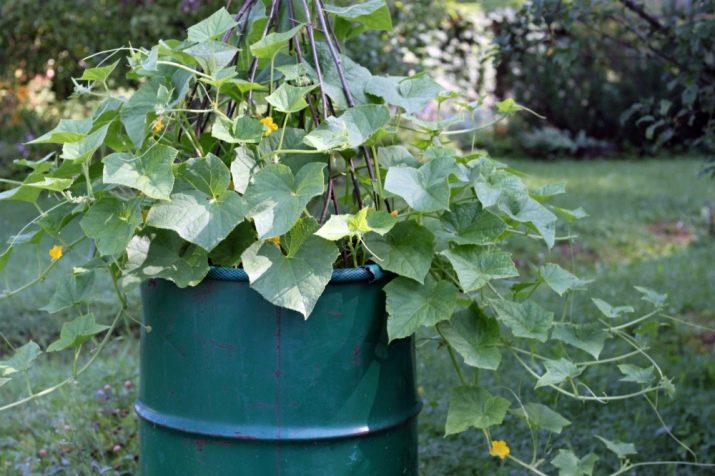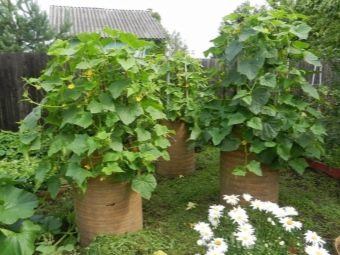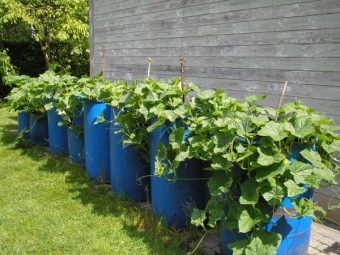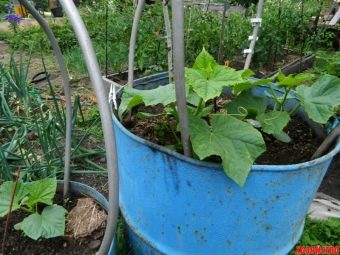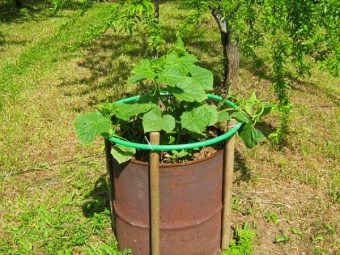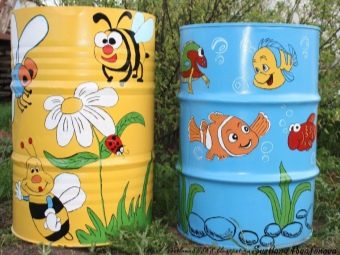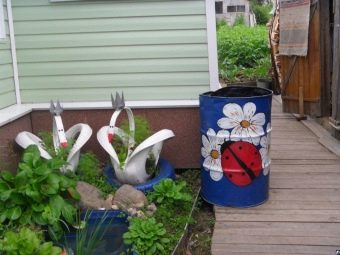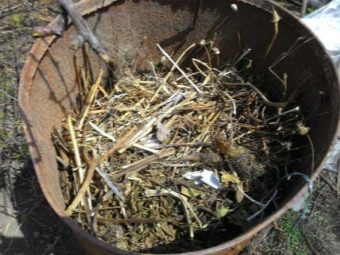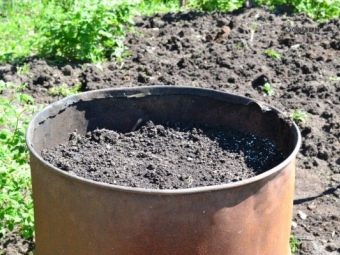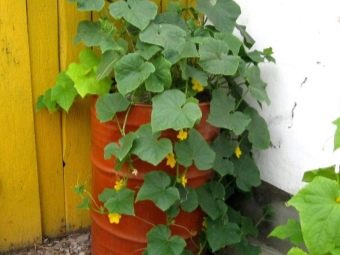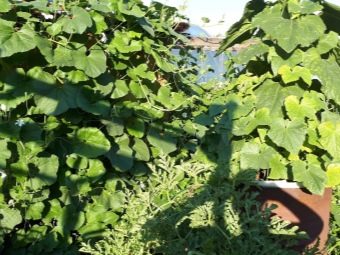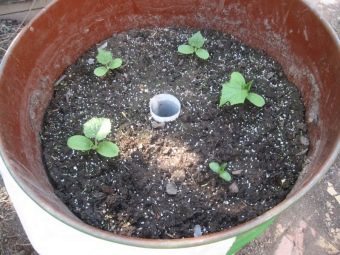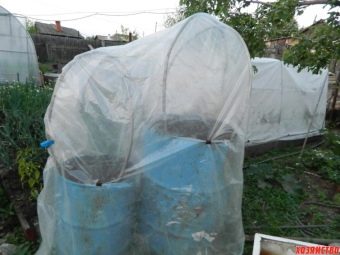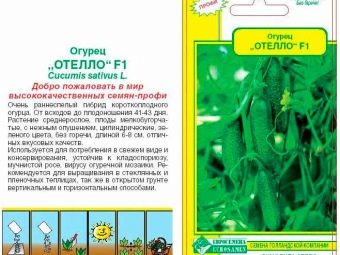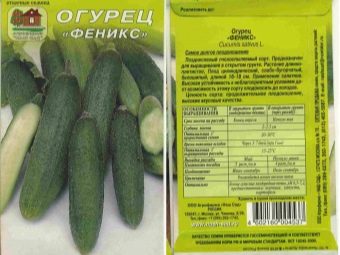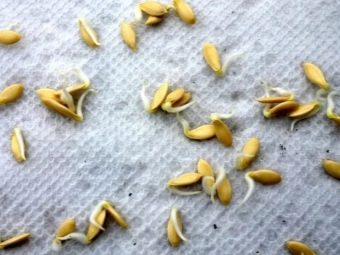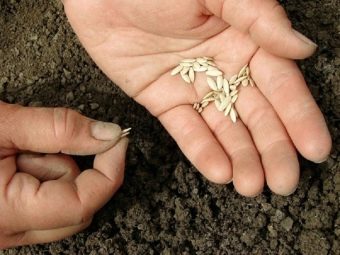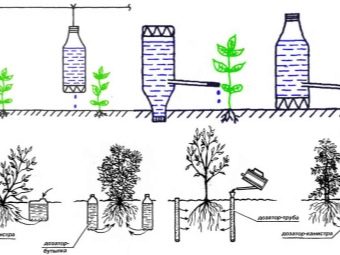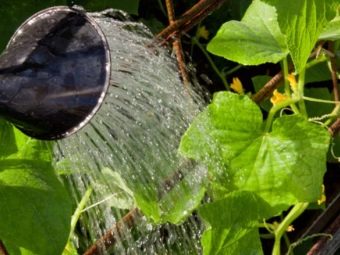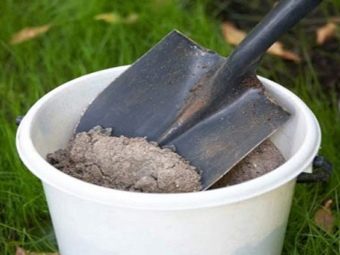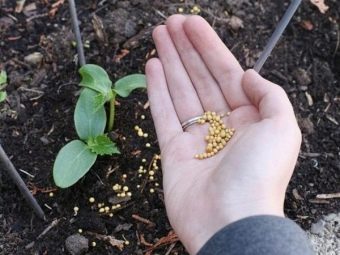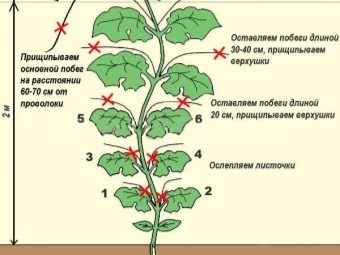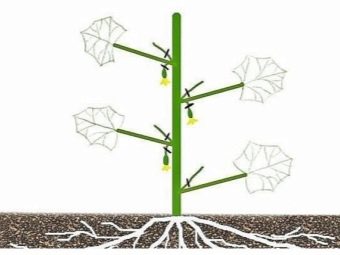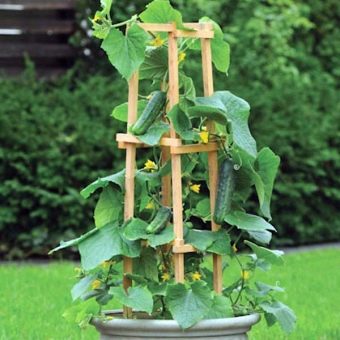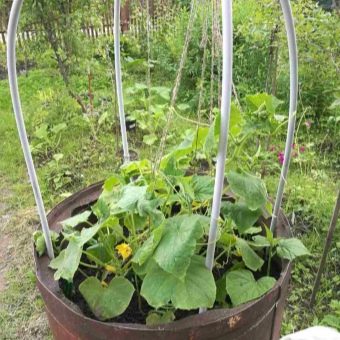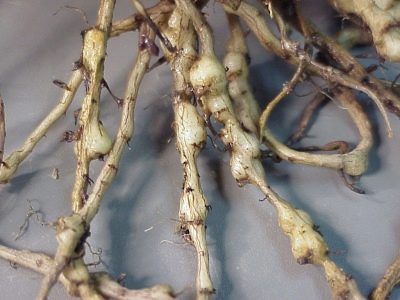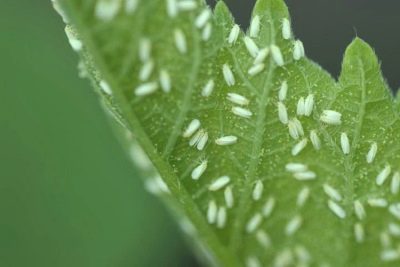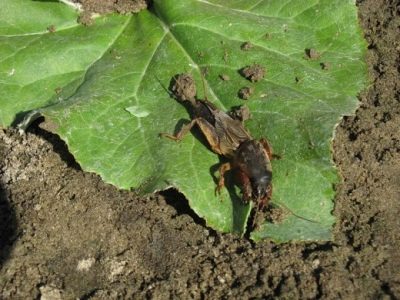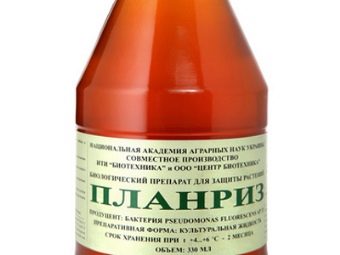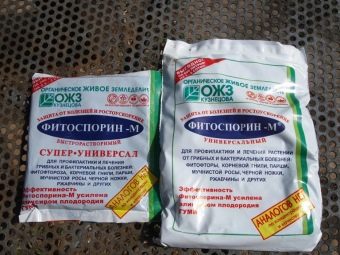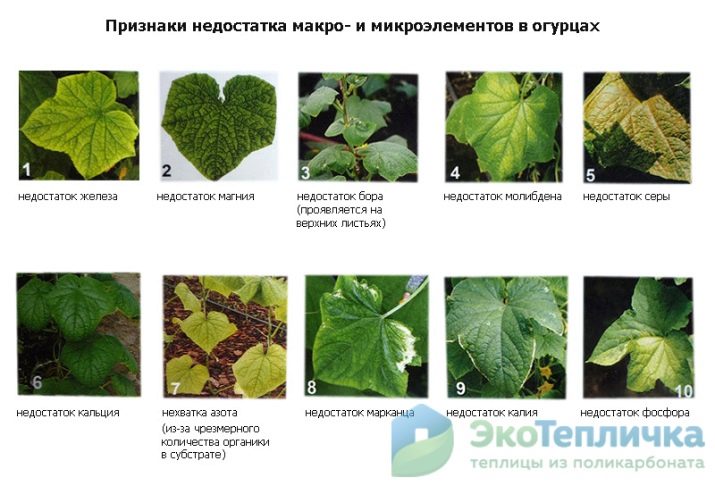How to grow cucumbers in a barrel?
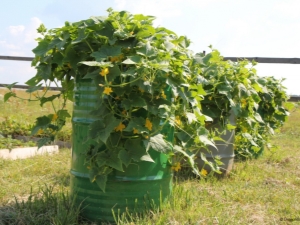
It is hard to imagine a modern suburban area without cucumber beds, although this vegetable is considered quite capricious.Fragrant fresh cucumbers are crumbled into a salad, pickled, salted and even added to soups. However, it is difficult even for an experienced summer resident to grow small and even fruits with pimples, therefore the most sophisticated agricultural practices are used. Someone uses flat-cutters instead of digging up beds, someone fertilizes the ground with green manure and grows a crop under a straw "fur coat". One of these techniques that has proven itself from the best side is the cultivation of cucumbers in a barrel method.
Features of the method
A relatively new method has come to domestic gardeners from China, where for many years they have received great harvests of cucumbers in just this way. Often in the barrel are early varieties, although it is suitable for any. Already in May, you can get the first crop of crispy green delicacy, which is perfect for both salad and salting. Best of all, with such a planting, self-pollinated varieties ripen, which produce many inflorescences. Of the bee-pollinated varieties, it is recommended to use the “Murom” or hybrid “Conny”.
It is possible to plant cucumbers of several kinds in a barrel so that this peculiar bed could bear fruit during the whole season.
According to reviews, the number of fruits obtained from such a landing can be compared with the yield of a wide bed of 1.5-2 m2. This is achieved due to the fact that the soil placed in the tank warms up several times faster than ordinary earth. Various additives / dressings do not spread over the entire area, but are concentrated in one place, where they serve only for culture, and not for all vegetation within a radius of several meters. It is possible to grow this method not only cucumbers, but also other crops, for example, tomatoes. However, like any other, this method has its pros and cons.
Benefits
The main advantage of this method is to save space. Even the smallest country house / garden is quite capable of placing a couple of round containers to grow vegetables in them. One 200-liter capacity will occupy an area of less than 1 sq. M, and replace a garden bed of up to 2 sq. M. In addition, a metal or plastic container filled with earth can be installed anywhere and even outside the front of the facade.
Thus, it is possible to grow cucumbers on asphalt sites, on gravel and in the sand. In addition, they can be moved at any time, choosing the most convenient at the moment location or in search of a more illuminated part of the country.
If the region is southern, then it is better to install such a barrel under the shade of trees so that the plants do not dry out under the scorching rays.
In addition, the fruits ripen in fenced soil much faster, such a soil should be processed much less frequently. The land does not have to weed often from weeds and loosen, and it is done much faster due to the small area. When harvesting there is no need to bend over each fruit, because they will be located approximately at the level of the belt. In this case, all the fruits are clean and well visible through the interweaving of leaves and stems.
Besides the fact that early ripening varieties in a barrel ripen faster, this method allows not to lose the harvest of late varieties in case of early frosts. Seedlings are less susceptible to various diseases and pests, which allows the use of fewer different fertilizers and chemicals that protect and nourish cucumbers.
At the end of the season, you can leave the contents of the container perepret, and then get a great loose substrate that is rich in humus. It can be used next year when planting fresh seedlings, which will reduce the amount of fertilizer applied to the soil.
Neat closed container always looks advantageous on the background of ordinary beds and even greenhouses. If desired, you can paint the outer surface of the barrel, thus obtaining an additional garden decor.You can install iron "beds", decorated with stones or wood, and you can turn them into a surface for drawing with chalk, which children will appreciate.
disadvantages
If there is no suitable container left after any purchases or inherited along with the purchased parcel, you will have to purchase it. Since such a purchase conceived can not be brought to the site independently, then you will have to pay for its delivery.
The downside of this method is the irrigation mode. Due to the higher temperature of the soil in the iron container, water from it evaporates much faster than in open space. This entails a tighter watering schedule, as well as the need for regular monitoring of this process. Leaving such seedlings left to itself will not work if there is no desire to lose a high yield.
Preparation of the tank with the ground
In order to plant seedlings in a properly prepared warm soil in the spring, you need to attend to the presence of proper packaging and soil preparation in it. The barrel may be made of metal, wood or plastic, but the latter option is not the best solution, because the plastic cools quickly at night, is not able to protect the soil from extreme temperatures. The volume of the container should be from 100 to 200 liters, since the larger size is quite difficult to find and install, and a smaller volume barrel is simply not advisable to use for planting vegetables.
If in some places the barrels rust the walls, and then holes appear, it is even good. Additional openings will ensure the outflow of excess moisture, will create proper air circulation in the soil. Moreover, in the new packaging, such openings will have to be done on their own, so that the soil is not broken, and the root system of vegetables is not too wet.
When the container is chosen, it is necessary to determine the place of its installation, because even putting an empty barrel is hard enough alone, and it is simply impossible to transfer it, filled with heavy wet earth. The best place will be a well-lit area near the trees, which can protect the tender leaves of young seedlings from the scorching heat. The place should be well blown by the summer breeze.
Looks great long stalks tied to high fences or located on the roof of a small gazebo, they resemble shoots of loach or wild grapes.
The last stage of preparation is the direct preparation of the soil for planting. It begins a few weeks before planting the first seeds and looks like this.
- At the bottom of the container stack drainage in the form of small twigs and stones. The height of the first layer should reach (minimum) 1/3 and maximum 1⁄2 of the height of the barrel itself.
- After the drainage layer fits everything that can be called compost. It may be hay, various sawdust or fine foliage. From above, such a nutrient medium is filled with humus or manure, and then watered with water with EM preparations diluted in it. Such an additive will speed up the process of further overblown. The second layer should fill the barrel so that to the top edge remains about 35-45 cm.
- The last layer is about 20-30 cm of quality soil, purchased in any store, which is mixed with ordinary garden soil in equal shares. Instead of land, you can use peat mixed with humus in the same proportion.
It is necessary to tighten the filled container from above with a thick food wrap, and then leave it in the sun for 1.5-2 weeks. The mixture during this time will squeeze a few, so when the film is removed, you will have to add soil or peat to the original level.
Landing
Before planting cucumbers, it is necessary to choose a suitable variety. It is best to grow early and mid-season vegetables in tare, which give the last fruits before the first frost. However, even if the harvest finds the first cold nights, the barrel will allow you to save the plants and protect them from freezing. According to reviews of experienced gardeners, it is best to stop the choice on certain varieties of cucumbers.
- "Murom 36" - develops well even in partial shade on the 35-45 day. The variety has oval fruits of a light shade, 10 cm in length. They are great for salting, not afraid of frost.
- Othello F1 - high-yielding bee-pollinating variety with early fruits. The length is about 12 cm, the color is saturated, it has small bumps. Crunchy pulp is perfect for both pickling and salad. Maturation term is from 40 to 45 days.
- "Temp F1" - high-yielding mid-season hybrid with short dark fruits. The variety perfectly tolerates excess moisture and cold, ripening for 43-50 days. The lack of bitterness will provide excellent taste in fresh.
- "Phoenix" - mid-season strong-growing cucumber variety, the fruits of which have yellowish longitudinal strips and large bumps. “Phoenix” matures at 55-60 day after planting, has dense flesh and crispy skin.
Sowing cucumbers in a barrel is somewhat simpler than in the ground, because it is not necessary to spend a long time in the slope above the bed. The landing scheme itself is quite simple and is carried out step by step.
- Before planting, seeds are poured with a solution of edible salt and water (1 liter of water and 50 g of salt). This is done to remove empty, unfit seeds that float to the surface of such a solution.
- After that, you need to harden the seeds in the cold. To do this, they are wrapped in a piece of cloth, wet and give a little swell. The swollen seeds, without removing them from the tissue convolution, are placed in a refrigerator for a couple of days in a temperature of -2 to 0 degrees. At the end of hardening, seeds are immediately planted.
- To disinfect the soil in the container, it is poured over with water with potassium permanganate dissolved in it.
- Seeds fall into the soil at a distance of 10-15 cm one from another to a depth of at least 2 cm. For a 200-liter barrel, only 4-5 plants are enough, but it is better to plant 8-10 pieces. Excess then it can be easily removed, but already empty places can not be planted.
- The barrel needs to be covered again with a thick food wrap, which is removed on sunny days, and returned to its place on overcast ones.
Care
To avoid mistakes, it is necessary to familiarize yourself with the subtleties of cucumber care. In a barrel it is much easier to do this than on the open field.
Watering
In order for a culture to develop properly and have a good fruit bearing, a certain amount of moisture is necessary. If it is not enough, the fruits will be small, and they can taste bitter. With its excess, the root system will begin to rot, and the fruits will be watery and fresh. Since the vertical bed dries faster, the outflow of water from the roots occurs faster in this case, the frequency of watering should be about 3-4 times a week. All the nutrients the plant receives from the water, so you need to water each bush, and not the whole area. Under the bush you need to pour at least 3 liters of settled warm water.
To achieve the best effect of watering the soil can be mulched with small sawdust.
Unlike ordinary land, an improvised automatic watering can be installed in the soil of a closed container. For this you need a plastic bottle and scissors. On the neck of such a bottle tightly twist the cap, and the bottom is cut off. A few small holes are made around the closed neck, through which water will penetrate into the soil. The prepared plastic container is buried in the ground in such a way that the cut edge protrudes 2-3 cm on the surface. It will be easiest to do this when the barrel is filled with soil. Water is poured into the bottle and, as it is absorbed, it is added to the soil as needed.
Top dressing
In spite of the fertilizers laid beforehand in the soil, cucumbers growing in a limited part of the soil need additional feeding. To bring a good harvest, plants must receive a large amount of nitrogen during the growth of the main green mass.The technology of adding fertilizers is quite simple: it is necessary to alternate complex species with organic ones. A solution of urea or nitrophosphate at the rate of one spoon per 10 liters of water is perfect as a complex top dressing. At one bush, you must pour at least a liter of solution.
As organic fertilizer, you can use the insignificant bird droppings, cow dung or dried herbs. They are infused for a couple of weeks at a rate of 1:10. It is believed that such supplements in their nutrients are not inferior to humus.
Shrub formation
For greater yields of a limited number of cucumber bushes in a barrel, they must be properly formed. Depending on the method of pollination, bushes can be formed in two ways.
- Self-pollinated cucumbers are grown by one stem. To do this, from the sinuses of the first leaves (4-5 pieces) remove all the flowers and branches, which are called stepchildren. From the following leaves only the stepchildren are removed, leaving the ovary and flowers. When the stem grows at a height of at least 1 m, they begin to leave branches little by little. The tops of the leaves, already grown on the stepsons, carefully pinch so that they form lateral shoots, rather than being pulled out by a new stem.
- Cucumbers, varieties of which are pollinated by bees, must be given a bush form. To do this, the 5th or 6th leaf is pinched from above, which gives active germination of stepsons. When on the side stepsons appeared on the 5th or 6th sheet, they are also pinched. This allows you to get a lot of side shoots on the stepsons. On the third-order stepsons, the ovary will actively appear. In addition, one of the bushes must be left unclosed in order to get hollow flowers with pollen that will be transferred between the bee plants.
Garter
In order for long shoots of plants not to spread on the ground and not to hang over the edge of the barrel, it is necessary to install a special support for them. Most often it is a high metal or wooden post with a cross-piece at the top, which is installed in the center of the barrel. Along the edges of the container, they drive in several small pegs, from which they pull the twine to the crosspiece and secure it.
When the first true leaves appear on the cucumber bush, they are tied to the stretched ropes so that subsequent shoots rise along them.
The second common way of garter cucumber seedlings are two cross-crossed arches dug along the edges of the barrel. They can be both metal and plastic. When the first leaves of the plants become large enough, they are tied to the arcs. Since the height of such a support is not too large, the longest lashes will hang around the edges, fray on the sharp edge. Avoid this will help ordinary rubber hose, cut through the length, and then worn on the edge of the barrel.
Diseases and pests
Various diseases and pests can significantly reduce the quantity and quality of the crop. In order not to lose the plants, you must carefully monitor the first signs of the appearance of pests.
- Gallic nematode. These are tiny worms that cannot be seen with the naked eye. To exclude infection by these parasites, it is necessary to conduct a preliminary soil test. To do this, you need to plant a few seeds in advance, and after receiving the first leaves, dig up seedlings and check their roots. On infected roots there are noticeable thickenings (galls). In order to get rid of parasites in the soil, it is necessary to treat the planting site with a solution of potassium permanganate or ordinary boiling water, and then cover it with a dark opaque film for several hours.
- Gourd aphid. Melon aphids are easily recognized by the shedding of flowers, as well as the loss of turgor (internal pressure) by the leaf plate. Large aphids can even be seen on the back of cucumber leaves. Various insecticides (“Commander”, “Iskra”) can be used against such a pest, if the ovary has not yet appeared, or biologics (“Bicol”, “Biotlin”) after their appearance.
- Whitefly. This is a small white midge. The first signs of the appearance of the whitefly are small bright spots on the sheets, and then a brood of the flies themselves. You can fight them with the help of the preparations "Fitoverm" or "Aktara".
- Medvedka. It is a cricket about 10 cm in length with front legs that look like bears. You can detect it by small holes in the ground - these are the moves of the bear. It is permissible to pour a soap solution into them or remove the nest itself by digging it out. There are also special chemicals "Thunder" or "Medvetoks".
In addition, there are also ants, various types of mites, tobacco thrips and sprout flies. For each of the pests, you can choose your own method of control. For example, ants are afraid of soda and cinnamon, tincture of garlic will save them from ticks, and digging flies - digging deep in the fall and plowing up manure. Tobacco thrips can only be derived chemistry. Perfectly cope with this "Aktara" and "Iskra".
Cucumber seedlings can suffer from various diseases. Most often it is fungal diseases. The most common types are:
- marty dew;
- gray or white rot;
- root rot;
- perinospora;
- cladosporosis;
- field and speckled mosaic.
The last two diseases are simply not treated, so the only thing that can be done is to harvest a healthy crop, and then destroy the diseased remains. Soil after the removal of diseased vegetables can not be used. It must be thrown away. The rest of the diseases are treated with the help of various solutions of potassium permanganate and soda, the drugs "Planriz", "Fitosporin" and others.
However, if the leaves grow dull and yellow, do not rush to purchase various chemicals. Perhaps this happens for very different reasons.
- Lack of nitrogen. It may be worthwhile to increase the number and frequency of feeding.
- Lack of moisture. It is necessary to increase the frequency of irrigation, to conduct additional loosening and mulching of the soil.
- Lack of light. If possible, move the barrel to where the lighting will be stronger.
- Lack of heat. Cucumbers are heat-loving plants, so a cold snap or night frosts will have a bad effect even on seedlings planted in a barrel.
Harvesting
In order to pick cucumbers for a long time to preserve their freshness and taste, it is necessary not only to grow them properly, but also to harvest them.
To remove the fruits is best in the early morning or late evening, when the sun has either not yet appeared, or is already setting. Grown up vegetables need to be collected daily, do not leave ripe cucumbers in a barrel. This is done to make the ovaries grow faster.
No need to pull the fruit with your hands or twist it, damaging the stem and stalk. It is best to cut the cucumber with ordinary scissors.
All mutated fruits (strange shapes, unusual sizes, with stains and damage) should be regularly monitored and removed so that the mutation does not spread to the entire crop.
Getting a good crop of cucumbers is easy enough if you grow them in a barrel. It will help save space and decorate even the simplest area. This method is perfect for gardeners in years and with poor health, because when planting and caring for vegetables do not need to bend over. It is necessary to choose the right container and prepare the soil, as well as to plant / provide proper care - then the crop will be pleased with the quantity and quality.
To learn how to grow cucumbers in a barrel, see the video below.

